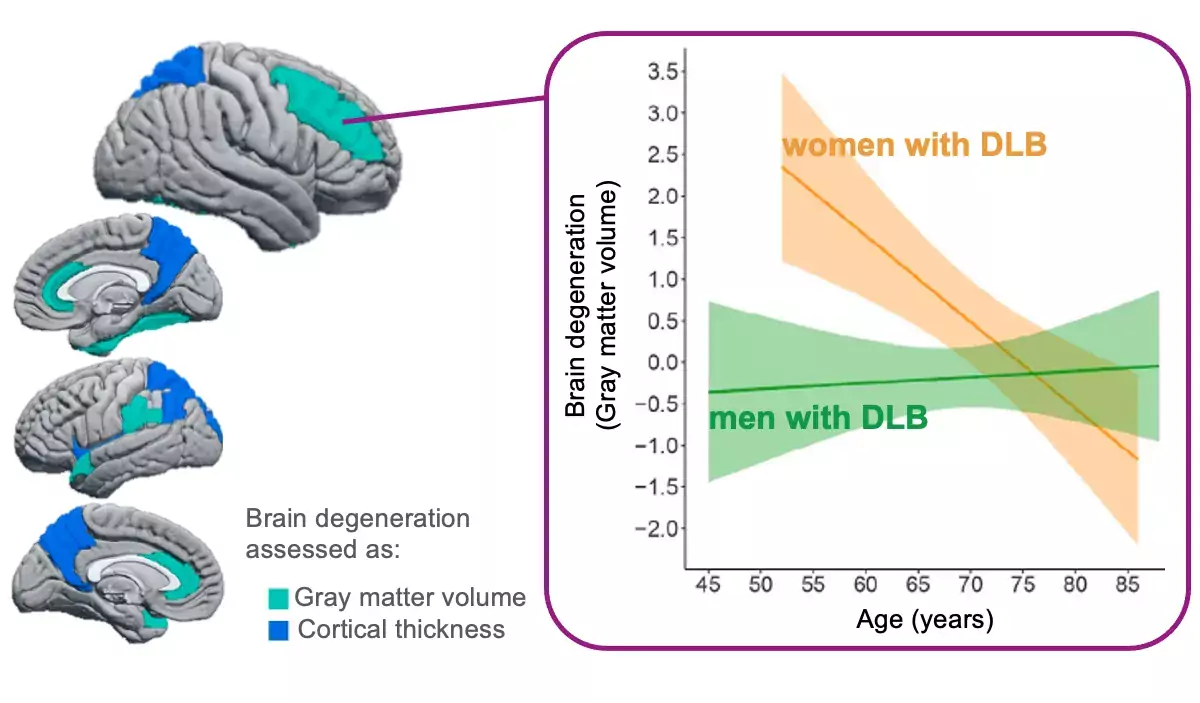A type of dementia that hits the brain of men and women differently

Dementia is a brain disease that affects mental capacities such as the individual’s memory, language, or capacity to understand and deal with emotions. Amongst the different types of dementia, dementia with Lewy bodies (DLB) is a relatively frequent dementia. Recently, there has been an interest in understanding better whether sex and gender play a role in DLB. Two recent publications from researchers at Karolinska Institutet addressed this question on sex differences in DLB.
Sex differences in dementia with Lewy bodies
During recent years, dementia care is moving away from treating all patients with the same approach. Instead, the individual characteristics of patients, for example, their sex, age, lifestyle, or previous personal history, influence how dementia is detected and treated. This individualized approach is particularly important in diseases that are very differently expressed across patients, like dementia with Lewy bodies (DLB).
For many years, it is known that sex must have an important role in DLB, since there are many more men than women with DLB. However, the reasons for this finding are not fully understood. Recent research has helped to clarify that, for example, men and women with DLB show different symptoms. While men with DLB are more likely to experience disturbances in their dream sleep and movement problems, women with DLB tend to experience more visual hallucinations.
Recent publication
Last December 2023, Dr. Javier Oltra and colleagues in the Ferreira lab published a study that has helped advancing our understanding of how the disease affects the brain of men and women with DLB. Drs. Oltra, Habich, Ferreira and colleagues led a large international collaboration between researchers at the Karolinska Institute, the University of Barcelona, the European DLB consortium, and the Mayo Clinic in Rochester, USA, in part facilitated by the Mayo Clinic and Karolinska Institutet Collaboration. Together, the researchers posed the question of how a patient's sex affects brain matter loss in DLB. The results of this investigation were published in the leading journal Alzheimer's and Dementia.
To answer the question, Dr. Oltra, Habich, Ferreira and colleagues analysed the world's largest DLB imaging dataset which includes data from 442 patients from 14 centres across Europe and the Mayo Clinic in the USA. The researchers applied two different methods to define brain matter loss. For the first method, a specialised medical doctor visually inspected images of the brain and judged whether brain matter loss occurs in large areas of the brain. That method is simple but relevant since it is the approach applied in clinical routine today, thus facilitating translation of findings from the research to the clinic. The second method used an advanced and automated procedure to assess the loss of brain matter in smaller brain regions.
The study revealed that men with DLB loose more brain matter than women with DLB across many brain regions, but particularly in regions at the front of the brain (frontal lobe). Interestingly, these sex differences were more prominent at younger ages of patients and decreased at older ages, with differences between women and men with DLB disappearing around the age of 75 years. The researchers also showed that the regional loss of brain matter in men was associated with cognitive problems and the presence of visual hallucinations.
Sex differences in brain atrophy in dementia with Lewy bodies.
Oltra J, Habich A, Schwarz CG, Nedelska Z, Przybelski SA, Inguanzo A, Diaz-Galvan P, Lowe VJ, Oppedal K, Gonzalez MC, Philippi N, Blanc F, Barkhof F, Lemstra AW, Hort J, Padovani A, Rektorova I, Bonanni L, Massa F, Kramberger MG, Taylor JP, Snaedal JG, Walker Z, Antonini A, Dierks T, Segura B, Junque C, Westman E, Boeve BF, Aarsland D, Kantarci K, Ferreira D
Alzheimers Dement 2023 Dec;():

Ongoing studies
Building on these sex differences in brain loss in DLB, the team conducted a second study led by Dr. Annegret Habich, this time using a network point of view. The network approach allows us to investigate complex patterns of brain matter loss that emerge across multiple brain regions instead of focussing on one brain region at a time. This is important as the disease underlying DLB, the so-called Lewy body disease, is assumed to induce the loss of brain matter and propagate across the brain along these brain networks, instead of being confined to one brain region. Their study showed that the sex differences in brain networks mainly arose between healthy women and healthy men, but the sex differences were diluted in patients with DLB. In line with the previous study, these findings highlight the importance of sex in DLB, and could explain why the disease propagates across the brain differently in men and women until sex differences disappear at the dementia stage of the disease.
Overall, the findings of these two studies suggest that the loss of brain matter starts earlier in men with DLB. In contrast, the loss of brain matter in women with DLB starts later but follows a more aggressive course. Therefore, while women and men with DLB ultimately reach similar levels in the severity of the disease, their respective disease process may differ drastically. Raising awareness of this issue will help clinicians detect the disease earlier and more accurately in women and men with DLB, which is the first step towards providing patients with adequate dementia care and treatment options.
Sex differences in grey matter networks in dementia with Lewy bodies.
Habich A, Oltra J, Schwarz CG, Przybelski SA, Oppedal K, Inguanzo A, Blanc F, Lemstra AW, Hort J, Westman E, Lowe VJ, Boeve BF, Dierks T, Aarsland D, Kantarci K, Ferreira D
Res Sq 2023 Jan;():
Participation of patients and funding
Of course, sex is not the only factor that has to be considered and future DLB studies will identify more factors that impact the patients' disease progression and the effectiveness of treatments. Studies like these rely on the invaluable participation of patients and funding agencies to support the research.
This project (Principal Investigator Dr. Daniel Ferreira) has received funding from the Swedish Research Council (Vetenskapsrådet), the Center for Innovative Medicine (CIMED), the regional agreement on medical training and clinical research of Stockholm Region (ALF Medicine), the Swedish Brain Foundation (Hjärnfonden), and contributions from private bequests. Last December and in synchrony with Dr. Oltra’s publication, the Ferreira lab received the news of a very generous funding allocation from the Swedish Alzheimer Foundation (Alzheimerfoden), which will support the continuation of these studies on sex differences in DLB.

Raising awareness and knowledge about dementia with Lewy bodies
As DLB is a disease that is challenging to diagnose and treat, collaboration and raising awareness about the disease is of the essence.
For the first time, there will be an international Lewy body day, the 28th of January. In the light of this, the Center for Alzheimer Research at Karolinska Institutet will dedicate a seminar to DLB on the 24th of January, which is open for everyone to listen and participate.
In the spirit of increasing the understanding and collaboration around DLB, Dr. Daniel Ferreira and Anna Rennie have started a national network together with Dr. Elisabet Londos from Lund University, the Swedish Lewy Body Network. In December 2023, they hosted an event at Karolinska Institutet with a focus on management of DLB, with around 50 participants in Flemingsberg and 200 virtual attendees. This Network is a step towards more equal care for patients with DLB in Sweden and a way to promote the interaction between researchers, clinical professionals, patients with DLB, and their relatives.
For more information, please contact:
Daniel Ferreira, Principal Researcher, Docent, Division of Clinical Geriatrics, Department of Neurobiology, Care Sciences and Society
Annegret Habich, Postdoctoral Researcher, Division of Clinical Geriatrics, Department of Neurobiology, Care Sciences and Society
Javier Oltra, Postdoctoral Researcher, Division of ARC, Department of Neurobiology, Care Sciences and Society
Anna Rennie, Phd student, Division of Clinical Geriatrics, Department of Neurobiology, Care Sciences and Society
This news is published in synchrony with the First International Lewy body Day taking place the 28th of January, to raise awareness and promote visibility about DLB.
